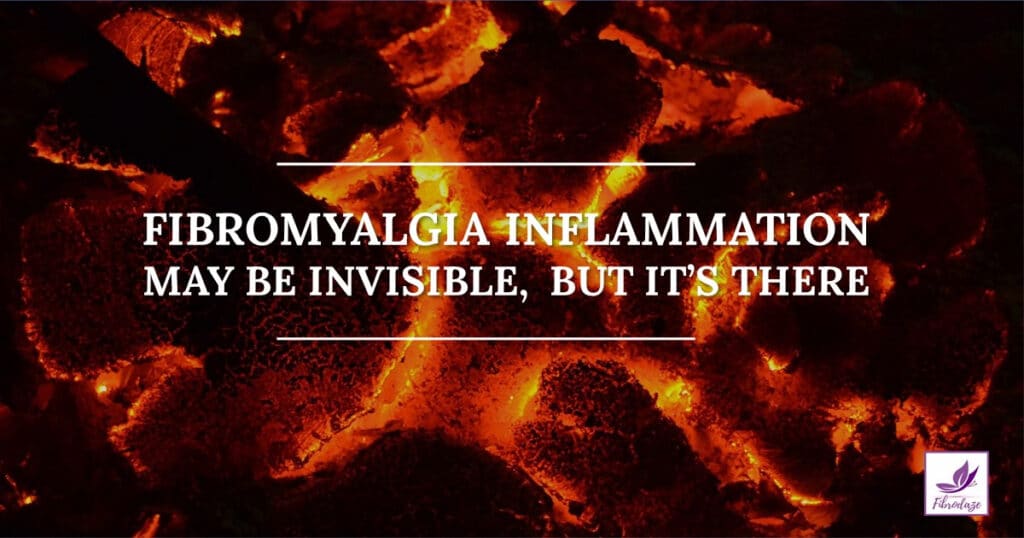The role of inflammation in fibromyalgia has been the topic of debate for decades. In fact, the condition used to be called “fibrositis,” which means “fibrous-tissue inflammation.” Due to an apparent lack of inflammation, the name was replaced with fibromyalgia (fibrous tissue and muscle pain) because it was believed to be more accurate. But now many researchers are finding connections with chronic inflammation that may contribute to the pain and fatigue of fibromyalgia.

Fibromyalgia is frequently referred to as an arthritis-related condition. However, it does not cause joint damage or inflammation, as arthritis does. Nor does fibromyalgia cause damage to muscle and other tissues. Because of this, it was believed that fibromyalgia was not an inflammatory condition.
In recent years, multiple studies have revealed several markers of inflammation in people with fibromyalgia, including high levels of C-reactive protein and pro-inflammatory cytokines.
C-reactive protein is produced by the liver. The level of C-reactive protein can be measured in your blood and increases when there is inflammation in your body.
Cytokines are proteins that are produced by cells which act as communicators in the immune system. There are both pro-inflammatory cytokines and anti-inflammatory cytokines. Pro-inflammatory cytokines promote systemic inflammation and play a key role in persistent and exaggerated pain states.
What Is Inflammation?
Inflammation is part of the body’s healing process. Without inflammation, infections and wounds would not heal. But inflammation can also be potentially harmful. There are two types of inflammation, acute and chronic.
Acute inflammation comes on suddenly from an injury or infection. It presents classic symptoms such as swelling, redness and pain. Acute inflammation is temporary, lasting from a few days to a couple of weeks, depending on the cause of the inflammation.
Chronic inflammation is long-term inflammation that lasts for months and years. It comes about slowly and sets the stage for chronic diseases. Heart disease, autoimmune diseases, neurological diseases, diabetes, cancer, Alzheimer’s, arthritis and many other conditions are linked to chronic inflammation.
The causes of chronic inflammation include poor diet, stress, lack of exercise, chronic infections, and allergens or toxins from food or the environment.
Inflammation In Fibromyalgia
For decades it was believed that fibromyalgia was not an inflammatory condition because it doesn’t appear like most inflammatory disease. Joints don’t look swollen and typical tests for inflammatory markers generally reveal normal or only slightly elevated levels in fibromyalgia. Whereas, diseases such as lupus and arthritis present high levels of inflammatory markers.
Fibromyalgia research has been focusing on the possible contribution of inflammation to disease progression, and is finding some interesting results. We now have evidence suggesting inflammation may play a role, after all.
These are some of the findings:
- Skin Cells – A study from 2010 showed elevated levels of mast cells – which release inflammatory chemicals in response to various triggers – in the skin of people with fibromyalgia.
- Fascia – Another study in 2010 suggests that it could be the fascia (a thin layer of connective tissue) that’s inflamed in fibromyalgia. The research concludes that fascial dysfunction and inflammation may be what leads to central sensitization, which is believed to be a core feature of fibromyalgia.
- Stress Response – In 2012, researchers found that there was an inflammatory state that seemed to be tied to an abnormal response to stress. They were unable to determine whether inflammation leads to stress dysfunction or stress dysfunction leads to inflammation.
- Mitrochondria – In 2013, Spanish researchers theorized that inflammation in fibromyalgia could be the result of dysfunction in the mitochondria (cells that break down nutrients to create energy).
- Brain Inflammation – Scientists have discovered that brain inflammation caused by chronic nerve pain can affect signaling in the regions of the brain associated with mood and motivation. This discovery suggests there is a mechanism that connects chronic pain with symptoms of depression and anxiety.
- Poor Sleep – Poor sleep quality and short sleep durations are associated with higher levels of inflammation. Scientists at Emory University School of Medicine in Atlanta, Georgia, found in a study that sleep deprivation or poor sleep quality raises inflammation.
Fibromyalgia Inflammation Treatment Options
Non-steroidal anti-inflammatory drugs (NSAID’s) and steroids are the primary treatments for inflammation. Unfortunately, anti-inflammatory medications have been tested in people with fibromyalgia and do not improve symptoms.
The options we have to lower our inflammation are listed below:
- Massage – Manual therapies that target the fascia may be effective. That includes trigger point therapy (myofascial release) and a deep-tissue manipulation called rolfing.
- Exercise – Exercise can suppress the production of pro-inflammatory cytokines. In separate studies, gentle exercises such as warm-water exercise and yoga have been shown to reduce cytokines in people with fibromyalgia.
- Supplements – Anti-inflammatory supplements include:
- Ginger
- CoQ10
- Omega-3 Fatty Acids
- Rhodiola rosea
- Turmeric (curcumin)
- Diet – Many doctors recommend an anti-inflammatory diet for inflammatory conditions. Although we don’t have research on whether it works for fibromyalgia. I have been following an anti-inflammatory diet for the couple of years and it has helped me.
Conclusion
Although there is no visible inflammation in fibromyalgia, the inflammatory factors are there and they are measurable. Multiple studies have revealed several markers of inflammation in people with fibromyalgia. Preliminary evidence suggests excess cytokines may be responsible fibromyalgia symptoms. These findings are uncovering new possibilities for fibromyalgia causation, as well as treatment options. Hopefully, in the not too distant future, we will have more answers and treatments that actually work.
Pin for Later






Have you all seen the three approx 13 to 17 minute lectures given by Dr Patrick Wood in You Tube? I strongly urge you to do so. He E plains what the use of three different Brain imaging scans have shown about the brains of Fibro people verses non-Fibropeople. It’s ground breaking information not related to cytokines causing Fibro.
No I haven’t seen the lectures. I will be sure to check them out. Thanks for the info.
I have Fibromyalgia – pain in all my deep soft tissues including the large muscles especially around the torso & neck, & in the internal organs like the bladder & GIT. I think the main cause is from huge on-going stress. I’ve been a nurse for 54 years, always in specialized fields, & have had a stressful personal life. I reached a stage where my body used up all its Adrenalin & was left with other hormones / chemicals in order to function. These alt hormones cause my pain! Also because I’m left with Adrenalin insufficiency I feel exhausted. Its like Type 2 Diabetes – Insulin insufficiency. I always have chronic pain, 4 or 5/10, (my body feels like I have on-going flu), but when I have extra stress, emotional or physical, I have serious acute on chronic pain, 7, 8 or 9/10. Analgesics don’t help this bad pain but I feel some relief from Ibuprofen. I feel as though I have run-away systemic inflammation! Remember,Florence Nightingale went to bed for a year – I don’t blame her! She had FM. THANKS FOR YOUR INFO – FOUND IT VERY USEFUL. Best wishes from Lee